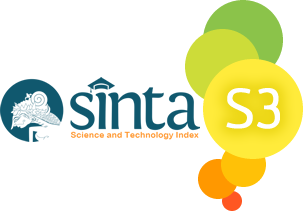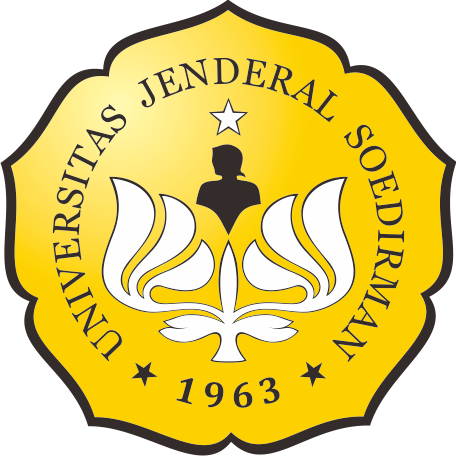SPIDER DIVERSITY (ARACHNIDA: ARANEAE) OF THE TEA PLANTATION AT SERANG VILLAGE, KARANGREJA SUB-DISTRICT, DISTRICT OF PURBALINGGA
Abstrak
Spiders are crucial in controlling insect pest population. The various cultivation managements such as fertilizer and pesticide application, weeding, pruning, harvesting, and cropping system affect their diversity. In the plantation, vegetation diversification has applied various practices, including monoculture, and intercropping, which influence the spider community. Thus, this study was intended to determine the spider abundance and diversity of the tea plantation, and the intercropping field (tea and strawberry) at Serang village, Karangreja Sub-District, District of Purbalingga. A survey and purposive sampling techniques were conducted, then the spiders were hand collected. Shannon-Wiener diversity (H’), Evenness (E), Simpson’s dominance (D), and Sorensen’s similarity (IS) indices were used to measure the spider diversity. The results revealed a total number of 575 individual spiders from 10 families, i.e., Araneae, Araneidae, Clubionidae, Linyphiidae, Lycosidae, Nephilidae, Oxyopidae, Salticidae, Tetragnathidae, Theridiidae, and Thomisidae. Araneidae was the most abundant in both fields. The total abundance of spiders in tea plantation (379 individuals), however, was greater than that in the intercropping field (196 individuals). Shannon-Wiener diversity reached H’= 1.873 in the plantation, and H’= 1.975 in the intercropping field.
Kata Kunci
Teks Lengkap:
PDFReferensi
Altieri MA, Nicholls CI. 2004. Biodiversity and pest management in agroecosystems. 2nd ed. New York: An Imprint of The Haworth Press Inc.
Altieri MA, Schmidt LL. 1986. Cover crops affect insect and spider populations in apple orchards. California Agriculture, pp:15–17
Andow DA. 1991. Yield Loss to Arthropods in Vegetationally Diverse Agroecosystems. Environmental Entomolology 20(5):1228–1235 https://doi.org/10.1093/ee/20.5.1228
Aswad M, Koneri R, Siahaan P. 2014. Komunitas Laba–laba (Arachnida:Araneae) pada Lahan Perkebunan di Kawasan Taman Nasional Bogani Nani Wartabone Sulawesi Utara. Jurnal MIPA UNSRAT Online 3(2):64–67
Barrion AT, Litsinger JA. 1995. Riceland spiders of South and Southeast Asia. Wallingford: CAB International; Manila:Int. Rice Res. Inst.
Brower JE, Jerrold CHZ, Von EIN. 1998. Field and Laboratory Methods for General Ecology, Third Edition. New York: Wm, C, Brown Publisher
Das S, Roy S, Mukhopadhyay A. 2010. Diversity of arthropod natural enemies in the tea plantations of North Bengal with emphasis on their association with tea pests. Current Science 99(10):1457–1463
Dippenaar–Schoeman AS. 1988. Annoted Check List of the Spiders (Araneae) of the Mountain Zebra National Park. Koedoe 31:151–160 https://doi.org/10.4102/koedoe.v31i1.492
Hawkeswood T. 2003. Spiders of Australia:an introduction to their classification, biology and distribution. Moscow, Russia: Pensoft.
Hazarika LK, Puzari KC, Wahab S. 2001. Biological Control of Tea Pests. In Biocontrol Potential and Its Exploitation in Sustainable Agriculture. Vol. 2: Insect Pests, ed. RK Upadhyay, KG Mukerji, BP Chamola, pp:159–80. New York:Kluwer Academic 421p https://doi.org/10.1007/978-1-4615-1377-3_11
Jimenez–Valverde A, Lobo JM. 2007. Determinants of local spider (Araneidae and Thomisidae) species richness on a regional scale: climate and altitude vs. habitat structure. Ecological Entomology 32:113–122 https://doi.org/10.1111/j.1365-2311.2006.00848.x
Magurran AE. 2004. Measuring Biological Diversity. USA: Blackwell Publishing Company.
Raychaudhuri D, Saha S, Roy TK. 2016. Spiders:A Proficient Candidate in Practising IPM for Darjeeling Tea. World Scientific News 38:1–62
Riechert SE, Lockley T. 1984. Spiders as biological control agents. Annu. Rev. Entomol. 29:229–320 https://doi.org/10.1146/annurev.en.29.010184.001503
Russell EP. 1989. Enemies Hypothesis: A Review of the Effect of Vegetational Diversity on Predatory Insects and Parasitoids. Environmental Entomology 18(4):590–599 https://doi.org/10.1093/ee/18.4.590
Schmidt MH, Tscharntke T. 2005. The role of perennial for Central European farmland spiders. Agriculture, Ecosystems and Environment 105:235–242 https://doi.org/10.1016/j.agee.2004.03.009
Suana IW, Solibin DD, Buchori D, Manuwoto S, Triwidodo H. 2005. Kolonisasi dan Suksesi Laba–laba (Araneae) pada Pertanaman Padi. Jurnal Biologi 9(1):1–7
Sugito. 2016. Paparan Kegiatan Pemerintahan dan Pembangunan Desa Serang. wawancara. Serang Karangreja Purbalingga.
Suin NM. 1991. Perbandingan Komunitas Hewan Permukaan Tanah antara Ladang dan Hutan di Bukit Pinang–Pinang Padang. Laporan Penelitian Universitas Andalas. Padang: Universitas Andalas
Symondson WOC, Sunderland KD, Greenstone MH. 2002. Can generalist predators be effective biocontrol agents? Annu. Rev. Entomol. 47:561–594 https://doi.org/10.1146/annurev.ento.47.091201.145240
Thomas CFG, Marshall EJP. 1999. Arthropod abundance and diversity in differently vegetated margins of arable fields. Agriculture, Ecosystem and Environment 72:131–144 https://doi.org/10.1016/S0167-8809(98)00169-8
Yan HM, Liu MY, Kim JP. 1998. Predation Efficiency of the Spider Tetragnatha squamata (Araneae:Tetragnathidae) to Tea Leafhopper Empoasca vitis (Insecta:Homoptera). The Korean Journal of Systematic Zoology 14(2):159–164
Article Reads
Total: 2649 Abstrak: 1860 PDF: 789Refbacks
- Saat ini tidak ada refbacks.

This work is licensed under a Creative Commons Attribution-ShareAlike 4.0 International License.
This website is maintained by:
Bio Publisher
The Faculty of Biology Publishing
Laman ini dikelola oleh:
Penerbitan Fakultas Biologi
Universitas Jenderal Soedirman
Jalan dr. Suparno 63 Grendeng
Purwokerto 53122
Telepon: +62-281-625865
Email: biologi@unsoed.ac.id
Laman ini menggunakan:
OJS | Open Journal System
Software pengelolaan jurnal ilmiah online. Versi yang digunakan adalah 2.4.8.0.
Metadata artikel terdaftar di:
Crossref
Agen resmi internasional pendaftaran Digital Object Identifier (DOI)
Artikel jurnal ini terindeks:








